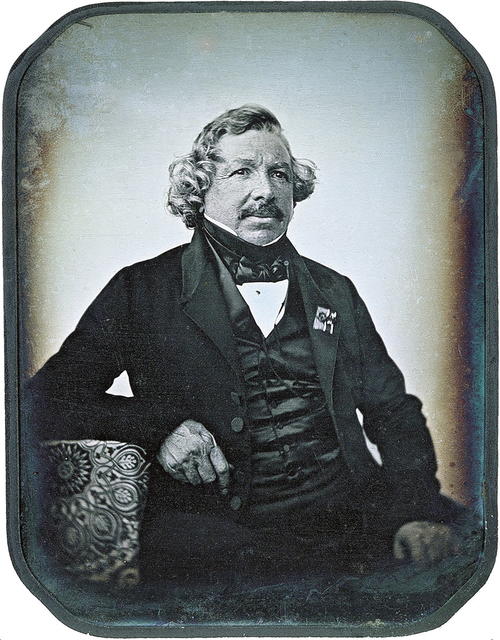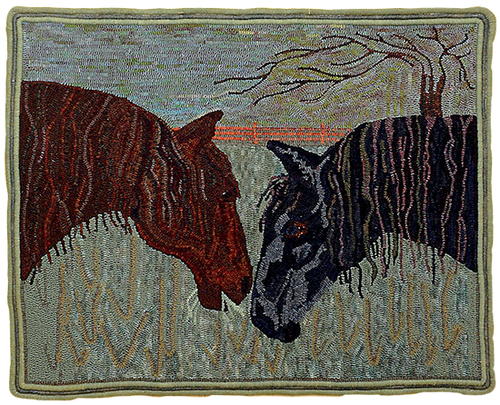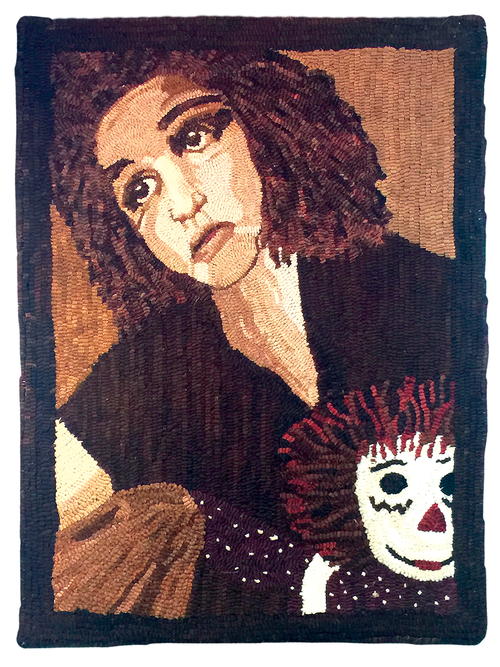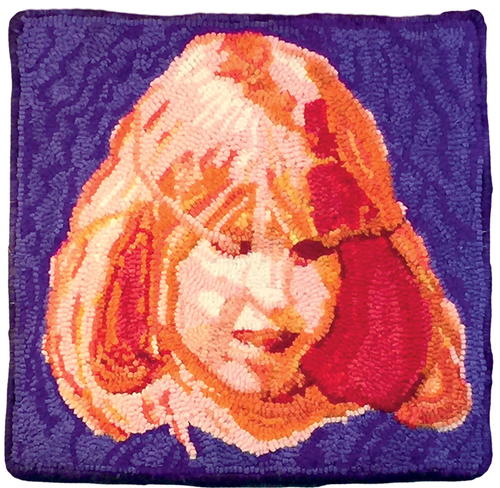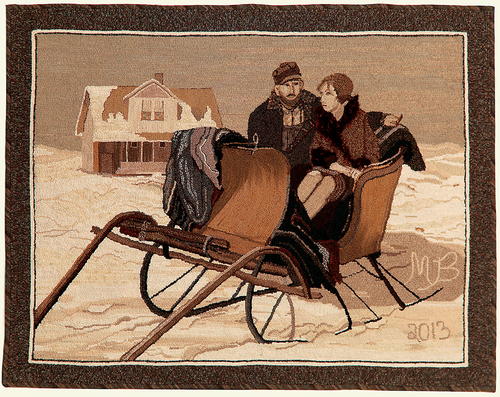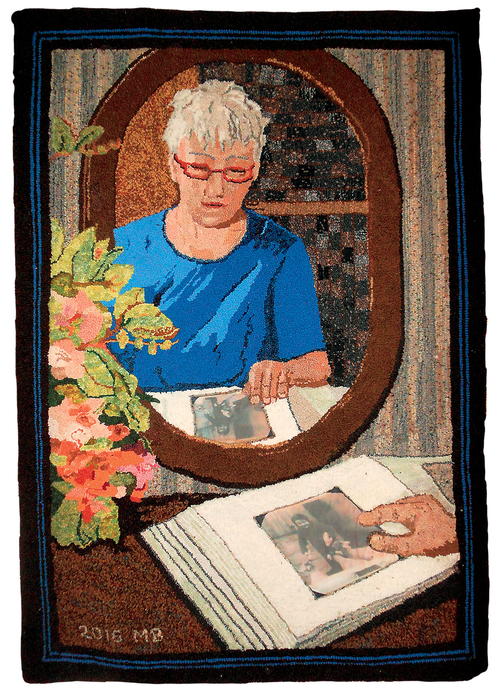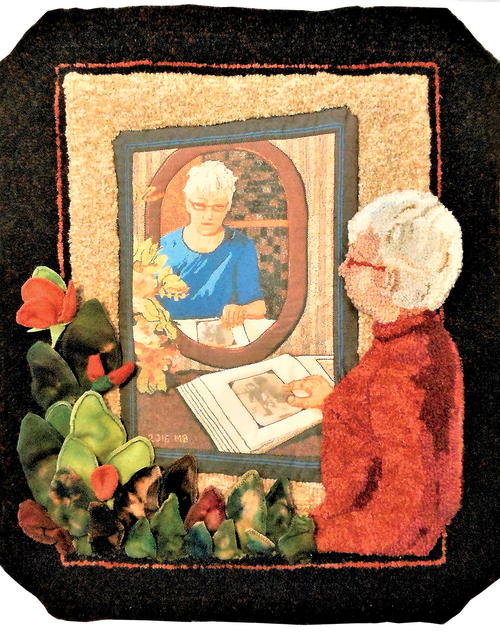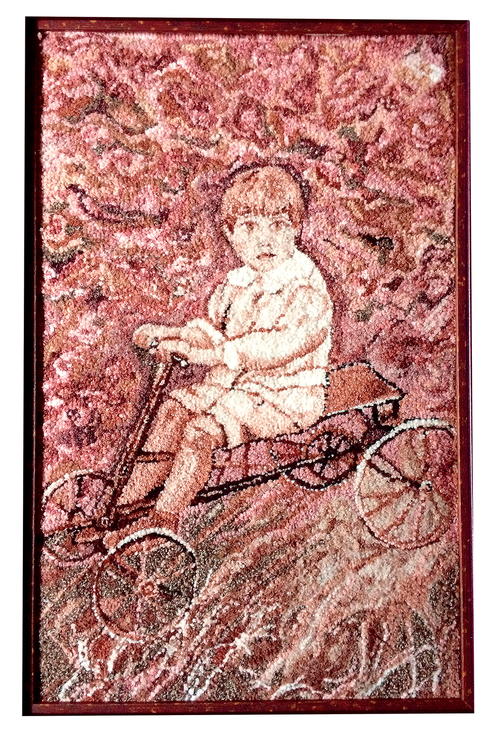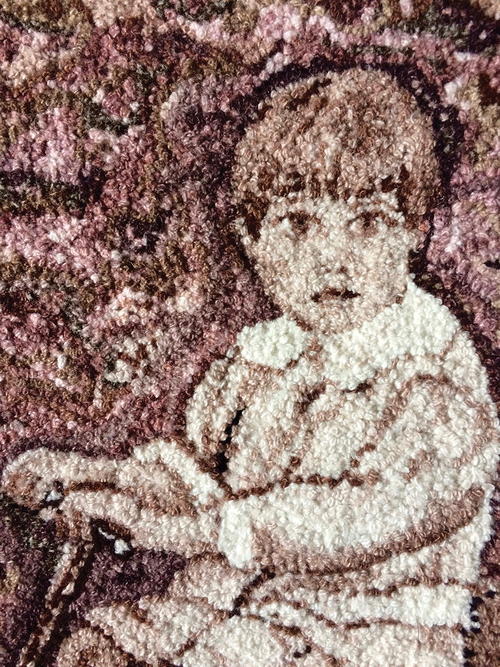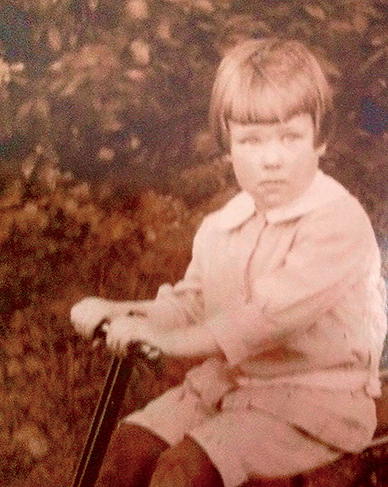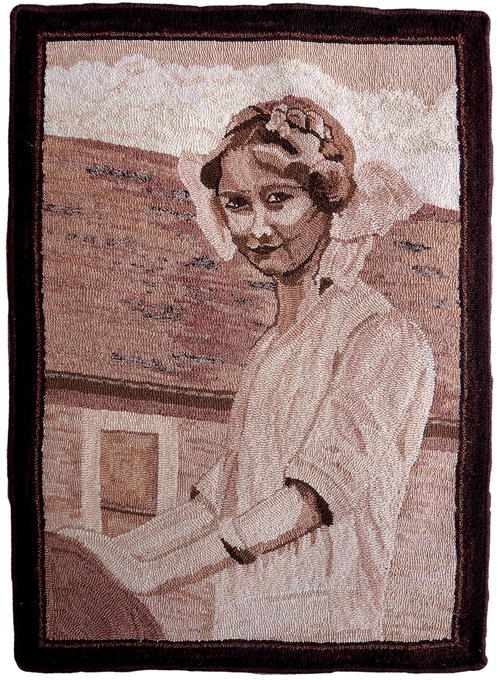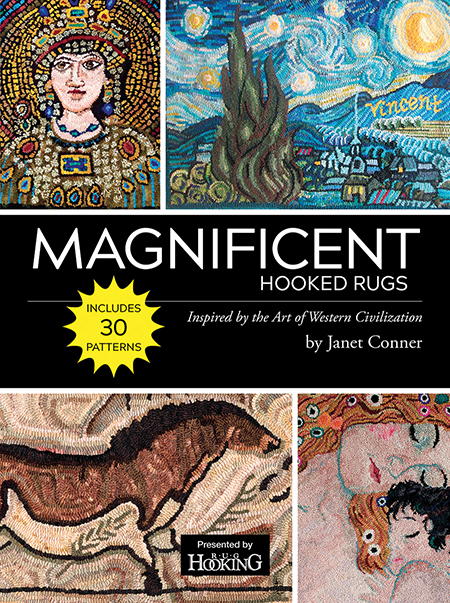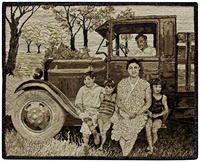From Photography to Hooked Art
Is That a Photograph? or Is It Hooked?
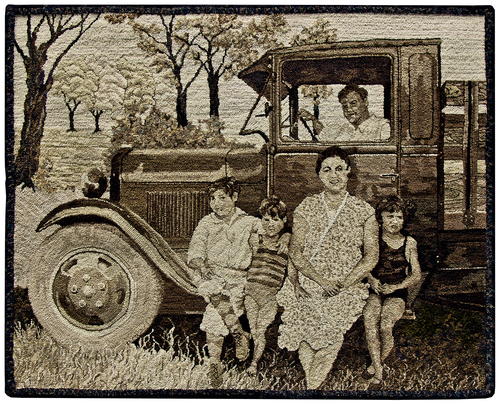
Martelotti Family Picnic 1928, 28½" x 35½", #2-, 3-, 6-, and 8-cut wool and threadwork on linen. Designed by Leonard Feenan from a family photo and hooked by Liz Marino, South Egremont, Massachusetts, 2013. Jane McWhorter
This stunning rug is so detailed and so perfect it absolutely takes my breath away.
The earliest experiments with photography began with the camera obscura, essentially a box with a tiny aperture—like a pinhole—that admitted the light reflecting from an object within its range. The image could be projected on to a surface using mirrors, and it would appear upside down. Artists as early as the sixteenth century used the apparatus as a means of tracing their designs, but no permanent image was created by the camera obscura itself.
Early in the nineteenth century, during the race to patent new inventions, chemists in different parts of the world each tried to create a photosensitive surface on which to make a print. Several different individuals contributed small but specific upgrades to the technology, but not until scientists teamed up could all the experiments bear fruit. Results were unpredictable and didn’t produce anything very clear, and for decades all innovations were used only to entertain crowds and amaze people. The entire process was initially too expensive and difficult to create any real competition for hand- drawn or hand-painted art.
Only after Louis Daguerre tried coating a metal plate with just the right chemicals in 1838 did photography begin to change the way the world thought of art. Continued improvements in photography replaced the need for fine-art, realistic portraits to be made by artists, except in the case of wealthy traditionalists. Photography gradually became the new portrait, landscape, and still-life method of recording history. This freed artists from the need to paint realistically, setting the stage for the advent of Impressionism. When artists were no longer compelled to represent reality, they were set free to paint their “impressions” and their “imaginary” worlds, eventually leading to modern art.
Like all major changes, there were steps forward and steps backward. The important factor for rug hookers is that the early daguerreotypes and the Eastman paper-development process yielded some hauntingly beautiful images. Rug hookers have made some very beautiful rugs from old (and new) photographs.
Additional Images (Part 1)
-
Louis Daguerre, inventor of the Daguerreotype. WIKICOMMANS IMAGES
-
Eli and Gordon, 40" x 50", wool on linen, with hand-dyed, whipped binding. Designed and hooked by Linda Beaulieu, The Villages, Florida, 2018.
Linda has spent her life around horses. “Eli and Gordon are registered Friesian horses, born in Holland and shipped to the U.S. as two-year-olds to be trained to ride and drive. They became the leaders in a four-in-hand of Friesians used for pleasure driving and showing. Eli, the brown horse, was injured and had to have an eye removed, but he was still able to do his work with his buddy by his side. Pastured together, Gordon watched out for Eli and let him know when the feed truck arrived. He would frequently bump Eli on the nose and transfer a mouthful of hay to him.” -
The Age of Innocence, 22" x 29", #6-, 7-, and 8-cut wool on linen. Adapted with permission from a photo by Rob Lohman. Designed and hooked by Lou Ann Ayres, Papillion, Nebraska, 2007.
“Hooking a monochromatic was a true challenge in learning where to place values and shading. I added a slight pop of color to the lips, so subtle that it is hard to notice. This was my frst portrait rug.” -
Michelle, 12½" x 12½", #4-, 5-, and 6-cut wool on linen. Designed and hooked by Lou Ann Ayres, Papillion, Nebraska, 2017.
“This was from a photograph I took of Michelle when she was nine years old. The photo was manipulated to achieve the colors I wanted. I used more than 30 colors to achieve the tonal changes in value and color.” -
Marry Me Mary, 37" x 47", #3- and 4-cut hand-dyed, as-is, and repurposed wool on rug warp. Designed and hooked by Marilyn Becker, Wassau, Wisconsin, 2013.
“Marilyn shows her mother, Mary Rose, in the horse-drawn sleigh in which she accepted Marilyn’s dad’s proposal of marriage. Marilyn used eyelash yarn for her mom’s collar and cuffs, and one of her father’s shirts for his shirt.”
My Favorite Dye Recipe for Sepia
This is what I use to accomplish the classic browns of antique photographs
(Sepia was originally sourced from squid ink!)
Sepia: Classic deep brown of antique photographs. Use Majic Carpet Dyes in this recipe.
1/4 t. MCD Seal Brown
toothpick 1/2” dip MCD Black
toothpick 1/2” dip MCD Chocolate Brown
How to Dye Graded Swatches
You will need:
•
Electric cooking pot (not a slow cooker) with a dial to control temperature at a simmer
•
Tongs, potholders, clear measuring cup, dye measuring spoons, large safety pins
• Dorr Natural wool, 1/3 yd.
•
Synthrapol or liquid dishwashing
detergent
• vinegar or citric acid
Method
For a six-shade graded swatch, which rug hookers love to work with, simply follow these steps. These instructions make two complete 6-shaded
swatches.
1.
Tear from the folded edge 12" (1/3 yd) Dorr Natural wool. Next, fold this into thirds (sideways), snip, and tear. You will have six pieces of 12" x 10" wool, which will result in
two matching six-shaded swatches at a final size of 12" x 5" (less shrinkage).
2.
Soak these sheets of wool in a sink of warm water and Synthrapol.
Wring out and place in a row near dye pot.
3.
Fill the cooking pot water 3/4 full with water and bring it to a simmer. Dip out a cup of the water, measure and mix dye formula per the recipe, and mix it into the cup. Pour this into the water in the cooking pot.
4.
Place first piece of wool into bath. Stir and watch as water returns to
a simmer and the swatch darkens
to the deepest shade desired.
Next add the second piece of
wool. Stir and watch for about 30 seconds; continue adding wool
pieces at similar intervals until all are simmering together, darkest through lightest. At this point, add 3 or 4 tablespoons of white vinegar or dissolved citric acid. When the dye bath clears, you are done!
5.
Run the wool pieces through the rinse cycle of your washer, and dry in automatic dryer with fabric softener sheets.
6.
Tear each wool sheet lengthwise to create a total of two six-shaded swatches. Pin together at the top edge with large safety pins.
Detail of Reflecting
This rug presents a self-portrait in the form of a rug within a rug. The foreground is enhanced and brought to the front by the appliquéd plant forms, while Marilyn herself “reflects” on the old family photograph in her mirrored reflection. Marilyn has created a series of intimate family-centered hooked rugs, priceless heirlooms for the ones she loves.
-
Reflecting, 30" x 42", #3- to 7-cut hand-dyed and repurposed wool on cotton rug warp. Designed and hooked by Marilyn Becker, Wassau, Wisconsin, 2016.
Additional Images (Part 2)
-
I found this to be very challenging, but exhilarating! Mariah Krauss dyed 14 shades of sepia for me, which at first I was afraid I would not be able to distinguish between. But by the end of the first day, I had added an additional two shades lighter and two shades darker to extend the range and provide more contrast for my elderly eyes. And we ended up with a beautiful spot dye from Mariah for the background foliage in a #3 cut (which felt like a #8 after the tiny threads in the clothing and face!).
-
Roger W. Thwing, Age 4, 16" x 24", single wool threads, #2- and 3-cut wool on cotton monk’s cloth. Adapted from a 1918 family photograph, and designed and hooked by Janet Conner, Hiram, Maine, 2016.
-
Mary Rose, 33" x 58", #3- and 4-cut wool on cotton rug warp. Designed and hooked by Marilyn Becker, Wassau, Wisconsin, 2014.
This rug was adapted from an old family photograph of Marilyn’s mother at age five. -
Grandma, 22" x 31", #4-cut hand-dyed wool on linen. Adapted and hooked by Jan Grose, Plain City, Ohio, 2013.
“When I first saw a sepia photo of my grandmother taken when she was about 18, I knew I wanted to hook it. Her impishness and playfulness, which continued even when she was in her 90s, is so evident in this photo. I knew this was the perfect opportunity to learn to apply Donna Hrkman’s monochromatic portrait techniques to a portrait of Grandma.”
Be sure to check out Magnificent Hooked Rugs, by Janet Conner, the new book from RHM. This article is an example of what you will find in those pages. We’re happy to provide this extra bit of Janet’s research and work, as she takes us through the history of art as seen through the eyes of contemporary rug hookers.
Janet Conner is an avid rug hooker who has been pulling loops since 1979. A graduate of Moore College of Art in Philadelphia, she spent 30 years teaching elementary art in southern Maine as she raised her family. Now retired, Janet works at rug hooking and fiber arts full time. She has a web-based business, which offers her own patterns as well as rug-hooking supplies and equipment, books, and natural dye recipe cards. She writes and teaches fiber arts in her home state of Maine and throughout the United States, Canada, Bermuda, and England. Her area of specific interest is art history and the inspiration found in both fine art and folk art. She is the author of Magnificent Hooked Rugs: Inspired by the Art of Western Civilization.


